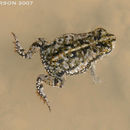en
names in breadcrumbs


Male oak toads make a high-pitched, bird-like chirping calls to attract females. Oak toads perceive their environment through visual, auditory, tactile, and chemical senses.
Communication Channels: acoustic
Other Communication Modes: choruses
Perception Channels: visual ; tactile ; acoustic ; chemical
Oak toad populations are declining throughout many states. In Virginia it is listed as a species of special concern (one that is not yet threatened but is expected to be in the near future). Also, in North Carolina, it is on the watch list for species that may be facing problems in the near future. A possible cause for decreases in oak toad populations is the clearing of the savannah forest habitats they prefer.
US Federal List: no special status
CITES: no special status
IUCN Red List of Threatened Species: least concern
In the span of two months, tadpoles hatch from their eggs and go through metamorphosis, becoming adult toads. Tadpoles have a grayish olive or grape green color to the body due to close set dots against a black background. The underside has a pale purplish color. the tail has 6-7 black saddles (coloration that wraps around the tail to a degree). Juvenile toads remain near the natal pond for a few days before moving to land, where they will spend the majority of their time.
Development - Life Cycle: metamorphosis
There are no known negative impacts of oak toads on humans.
Oak toads help control population levels of insects and other small arthropods.
Positive Impacts: controls pest population
Although smaller than other toads, the Oak Toad still plays a crucial role in insect population control.
Oak toads are predaceous and feed primarily on terrestrial insects and other small arthropods.
Animal Foods: insects; terrestrial non-insect arthropods
Primary Diet: carnivore (Insectivore , Eats non-insect arthropods)
Oak toads are found in the coastal plains of the southeastern United States. They are found from the southern tip of Florida to the southern portion of Virginia and to parts of eastern Louisiana.
Biogeographic Regions: nearctic (Native )
Oak toads are generally found in moist, grassy areas near pine or oak savannahs with sandy soil. They are also found in vernal pools and freshwater wetlands. They breed in shallow pools, ditches, and ponds.
Habitat Regions: temperate ; terrestrial ; freshwater
Terrestrial Biomes: savanna or grassland ; forest
Aquatic Biomes: lakes and ponds; rivers and streams; temporary pools
Wetlands: marsh
Oak toad lifespans are not well known.
Average lifespan
Status: captivity: 1.9 years.
Anaxyrus quercicus is the smallest toad species in North America, ranging from 1.9 to 3.3 cm. It is so small that adults found in the wild were commonly classified as “half-grown” or “juvenile” southern toads (Bufo lentiginosus). They have a short head with a pointed nose and the short, flat body is black or brown in color (color can change with temperature) with a long dorsal stripe that may be white, cream, yellow, or orange. There are 4 to 5 pairs of dark blotches found on the back. The back is finely tuberculate, with the fine bumps (red, orange or reddish-brown in color) giving it a rough texture. The underside is grayish white and has no blotches, but is covered in tubercles. Oak toads have elongated, teardrop-shaped paratoid glands that extend down either side. These glands house a poisonous fluid used deter predators. Males can be distinguished by their dark, dusky colored throats.
Range length: 19 to 33 mm.
Other Physical Features: ectothermic ; heterothermic ; bilateral symmetry ; poisonous
Sexual Dimorphism: female larger; sexes shaped differently
The primary predators of oak toads are snakes, particularly hognosed snakes (Heterodon platirhinos), specialized for eating toads. Other predators of oak toads are garter snakes (Thamnophis sirtalis) and gopher frogs (Lithobates capito).
Known Predators:
Anti-predator Adaptations: cryptic
Males arrive before females at shallow, semi-permanent or temporary ponds, and roadside drainage ditches. At breeding ponds males establish territories and begin calling females with a high-pitched chirp. Approximately 100-250 eggs are laid at a time in long strings, held together by a gelatinous material, and either float or stick to surfaces. Fertilization takes place externally when the male frog releases his sperm in the vicinity of the eggs. In the case of a testicular malfunction, male oak toads have an ovary that will become functional, allowing them to breed as females.
Mating System: polygynandrous (promiscuous)
Male and female oak toads form a pair when the male grabs onto the female from behind in a position referred to as amplexus. The male stays attached to the female until she releases her eggs into the water. The female emits several eggs and then the male releases sperm into the water. The female will continue to release eggs. The eggs are released in bars containing 4-6 eggs apiece. Each female will lay about 700 eggs in total in a single season. These eggs will hatch within 3 to 3.5 days and develop into adult oak toads within 2 months.
Breeding interval: Oak toads are seasonal breeders and breeds once per year.
Breeding season: Oak toads breed from April to September or October. The mating season often begins with the arrival of warmer temperatures and thunderstorms. The interval of ovulation is approximately late May-mid August.
Average number of offspring: 700.
Range time to hatching: 72 to 80 hours.
Average age at sexual or reproductive maturity (female): 2 months.
Average age at sexual or reproductive maturity (male): 2 months.
Key Reproductive Features: iteroparous ; seasonal breeding ; gonochoric/gonochoristic/dioecious (sexes separate); sexual ; fertilization (External ); oviparous
The extent of female energy investment is great during the ovulation and mating periods, as many females are found dead during these periods due to either the rigors of pair formation or energy investment in the laying of eggs. Once the eggs are fertilized and attached to a surface, there is no further parental care.
Parental Investment: no parental involvement; pre-fertilization (Provisioning)